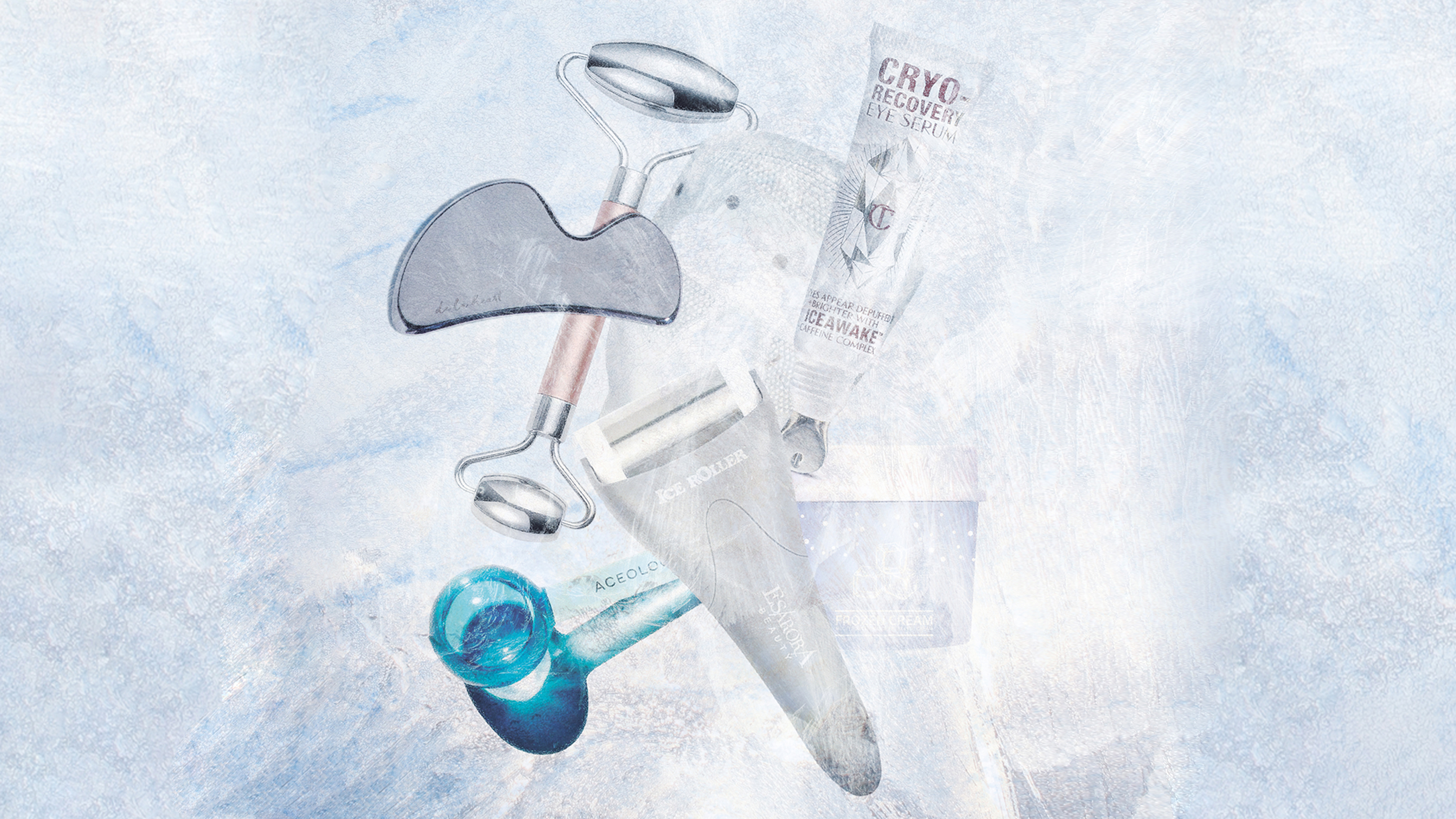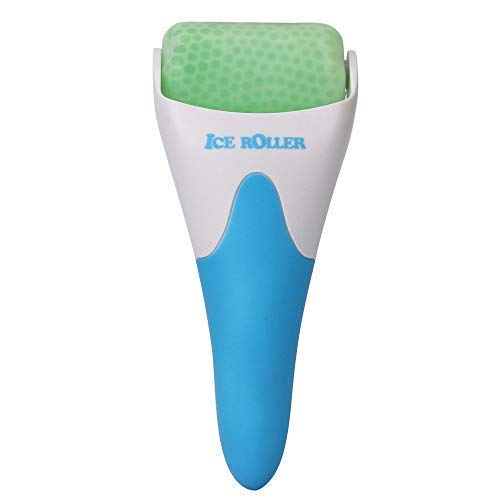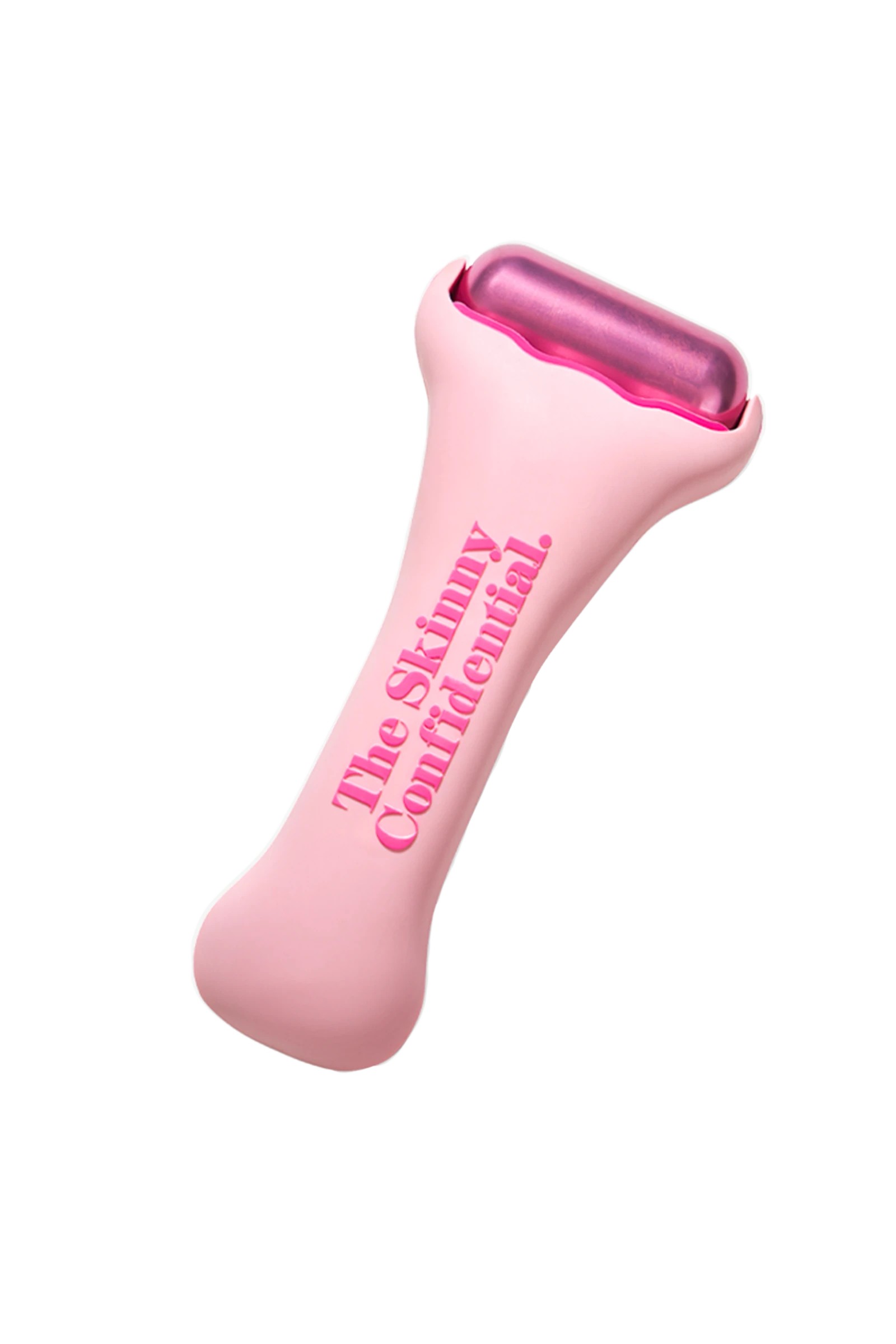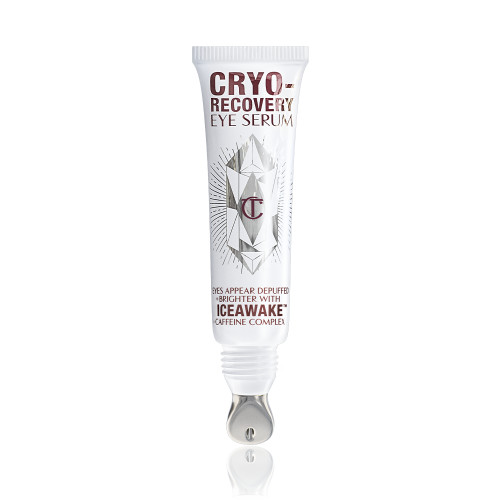The Hottest New Beauty Trend Is Ice Cold
These ingenious cryotherapy-inspired finds are worth bearing the chill.

Some mornings, your skin can look as tired as you feel. Even after your PM routine (eye cream, retinol, the works) and attempted concealing, your visage may still require an extra jolt. As a mom of 2-year-old twins, I know these mornings well. There’s a new way to perk up, and it’ll send a chill through your skincare regimen: cryotherapy, the beauty equivalent of a Venti cold brew.
At its most basic, cryotherapy is the employment of cold for the treatment of skin conditions. The oldest application by doctors, dating back to at least the 1950s, is the use of liquid nitrogen to treat issues like warts, pre-cancers on the skin, or sun spots. You may have heard of it recently because your favorite athlete or influencer took a turn in a futuristic, full-body cryotherapy pod. The technology has been gaining popularity as a way to enhance recovery after injuries—just spend a few minutes in a chamber of dry air at temperatures lower than −110°C. (The buzzy full-body freezes may not do much good, though; a 2019 paper in Scientific Reports found whole-body cryotherapy as having no significant effect on athletic performance.)
Despite its longstanding dermatological uses, cryotherapy has evolved over time. So has skincare. With both consumers and brands constantly seeking the latest and greatest innovation, it’s no surprise the beauty industry is tapping into the practice’s ice-cold powers. The entire cryotherapy market at large is projected to reach $392 million by 2030, according to a projection from Allied Market Research. “Consumers will always be in the market for the next big promise for great skin and love quick fixes,” says Rachel Maiman, M.D., a board-certified dermatologist based in New York City. “[Cryotherapy and these chilling] devices capitalize upon being short treatments without a prolonged time commitment.”
They used to say, ‘Slap your cheeks, it'll make you look pretty,’ so perhaps that’s what consumers find appealing.
Macrene Alexiades, M.D.
See: the cryofacial, a service offered by dermatologists, wellness boutiques, and medispas, in which the vaporized nitrogen—cooled to a sub-zero temperature—is pumped from a hose-like device on the face, neck, and decolletage. Colloquially known as frotox, the painless (for most) procedure has a near-instant depuffing and visible tightening effect. The reason why? Reduced inflammation, says Dr. Maiman. “The extremely cold temperatures (around minus 322 degrees Fahrenheit) of the liquid nitrogen constricts blood vessels, which in turn also helps to alleviate redness,” or puffiness caused from a late night with too little sleep.
“In the golden days, they used to say, ‘Slap your cheeks, it'll make you look pretty,’ so perhaps that’s exactly what consumers find appealing,” about cryotherapy and cooling treatments, says Macrene Alexiades, M.D., Associate Clinical Professor at Yale University School of Medicine. “When you get that reactive vasodilation after the cold therapy, evaporative cooling occurs, but you also will get some swelling to the skin,” she adds. The temporary result is that the skin is a bit rosy, which gives the appearance of a more youthful glow and rejuvenated complexion.
But if you want to skip the spa, there are many cryo-inspired facial options to give you that fresh-faced effect, no appointment required. In fact, there’s a good chance you’ve already experimented with cryotherapy—kind of, at least—without even realizing it. If you’ve ever stashed eye cream in the fridge or relaxed with a pair of cucumber slices over your eyes, surprise: You’ve dipped your toe in the icy cyro waters.
As the outside temperatures inch up, here are some ways to grab a quick, frosty pick-me-up from the confines of home—or wherever the warmer weather may take you.
Get exclusive access to fashion and beauty trends, hot-off-the-press celebrity news, and more.
The tool that started it all
Make room in your freezer to store this quick-hit, cryo-inspired tool that basically kicked off the entire trend as a leveled-up version of the jade roller. The cooling effects of an ice roller are short-lived, but fans swear the results are noticeable. “Ice rollers can help boost the appearance of skin when you wake up to look more awake and alert, as the cold temperatures can help reduce superficial inflammation,” explains Bruce Katz, M.D., a board-certified dermatologist in JUVA Skin & Laser Center in New York City.
What your ice roller’s made from depends on which one you purchase. Some, including what’s considered the OG by many beauty obsessives: The ESARORA Ice Roller, have long handles and either a water- or gel-based substance encased in plastic. Then there are ones like the beloved recent launch from Lauryn Evarts Bosstick, a podcast host, mega-influencer, and founder of The Skinny Confidential, which are made from metal. In Bosstick’s case, the Hot Mess Ice Roller, is 100% aluminum and has seriously devoted fans who espouse the roller's depuffing, firming, and awakening abilities. (And because it looks cute on TikTok, too.)
To get the biggest bang for your buck, stow any facial roller in the freezer for at least an hour or two. Once it’s super-cold, massage your face using gentle pressure. To maximize the lifting and firming benefits, Dr. Katz suggests you “rub in upward motion to avoid tugging down on the skin.” Roll downwards on your neck to help with lymphatic drainage, visibly improve the appearance of fine lines and wrinkles, while also sharpening your jawline and minimizing any puffiness or swelling.
The new kid on the block
Ice globes are another cryo-inspired at-home tool that you’ve probably spotted while scrolling through Instagram or TikTok. In December 2021, searches for the term “ice globes” jumped a whopping 194 percent from the month prior, according to global search platform Stylight. Hashtag #iceglobes has 12.9 million views on TikTok. Chilling stuff, right?
Simple in concept, just fill a set of two plastic orbs with water, and pop into the freezer for at least 15 minutes before using them similarly to any other facial massager. If you’ve seen any of your favorite influencers singing the praises of ice globes, there’s a solid chance they’re talking about the Aceology The Original Blue Ice Globe Facial Massager.
The skincare inspired by the science
For the tool-averse, Charlotte Tilbury and 111Skin are among the brands that have jumped on the frigid bandwagon, offering new skincare products with cryo-like benefits. The lines contain different products for different treatments—Cryo-Recovery Depuffing Eye Serum and Sub-Zero De-Puffing Eye Mask, respectively—but both contain forms of caffeine, which purportedly mimics the effect of at-home cryotech tools and devices.
Menthol—you know, that oh-so-minty, oh-so-strong scent that powers Icy Hot—is another cryo-inspired skincare ingredient. You’ll find it in some cooling masks for whenever your face needs a refresh. “Caffeine and other methylaxelines constrict the vessels thereby reducing flushing and edema and reducing skin temperature,” explains Alexiades. But what’s important to note, adds Alexiades, is that these ingredients only work on abnormally dilated vessels—think puffy under eyes after a night of too much sushi, a few cocktails, and not nearly enough water.
The totally free, DIY version
As with any good beauty trend, there’s a way to mimic at-home cryofacial effects without spending a single buck. Your secret cryo tool? An ice cube.
“Start by wrapping your ice in a piece of soft gauze to avoid potential frostbite [more on that in a minute]—same goes for keeping the ice in one place for too long,” explains Dr. Maiman. “Move the ice cube along the underside of the jawline from chin to ear, trace the orbital bone [under eye] from its innermost portion outward, work in upward motions on the cheeks and speed over the forehead to finish, for about 5 to 10 minutes.” These specific movements will help to optimize lymphatic drainage, helping to decrease puffiness.
Regardless of the tool you use, it’s the physiological evaporative cooling and consequential rebound of skin after exposure to cold that leaves skin temporarily tightened, depuffed, and glowy. Pro-level results can last a week or two, but expect your DIY version to last less. As with nearly everything, though, consistency is key. The more regularly you massage your face, the more firming effects you’re going to see.
Taking the plunge: Is it worth it?
You might be hesitant to give ice a chance following supermodel Linda Evangelista’s highly publicized lawsuit regarding her bad reaction to CoolSculpting (an FDA-approved, non-surgical fat-freezing treatment)—but that’s not what we’re talking about here. Both treatments use cold temperatures in a non-invasive way, but cryofacials and at-home tools can aid in tightening skin and helping you feel rejuvenated, while CoolSculpting (scientific name: cryolipolysis) focuses on minimizing stubborn fat in targeted areas.
That said, extreme cold can have its downsides. Frostbite is the most well-known and most common side effect of cryotherapy, whether after receiving a spray of liquid nitrogen or massaging an ice cube into your face. Frostbite causes damage to blood vessels, which in turn gives skin that abnormal reddish-purple tinge.
What’s more, frostbite takes a while to recover from, given the potentially extensive capillary damage. “If somebody's [frequently overusing cryotechnology, it’s possible] they could get permanent damage to the capillaries in their faces,” Dr. Alexiades says.
Those who deal with rosacea, which is a skin condition that causes blushing or flushing and visible blood vessels in your face should, avoid any type of cryotherapy—at-home or in-office, says Dr. Alexiades. “While cold may constrict the blood vessels temporarily, blood vessels ultimately rebound worse…the minute the cold is removed, the rosacea flush returns even more.”
As for me, I’ll be carefully taking the cryotherapy plunge by stowing some of these cool tools in the fridge to help depuff my perennially bagged, twin-mom under eyes. After a middle of the night wake-up, there’s no cooler reassurance than knowing there’s an ice roller in the freezer ready to rescue me before starting my day.
This story appears in the May 2022 issue of Marie Claire.
Rachel Jacoby Zoldan is a freelance writer and editor. Her work has appeared in outlets including Racked, the Business of Fashion, Teen Vogue, Glamour, Shape, W, and SELF.




